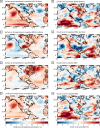Sea surface temperature variability and ischemic heart disease outcomes among older adults
- PMID: 33564043
- PMCID: PMC7873280
- DOI: 10.1038/s41598-021-83062-x
Sea surface temperature variability and ischemic heart disease outcomes among older adults
Abstract
Ischemic heart disease (IHD) is one of the leading causes of death worldwide. While extreme summer surface air temperatures are thought to be a risk factor for IHD, it is unclear whether large-scale climate patterns also influence this risk. This multi-national population-based study investigated the association between summer Pacific and Atlantic sea surface temperature (SST) variability and annual acute myocardial infarction (AMI) or IHD event rates among older adults residing in North America and the United Kingdom. Overall, a shift from cool to warm phase of the El Niño Southern Oscillation (ENSO) was associated with reduced AMI admissions in western Canada (adjusted rate ratio [RR] 0.89; 95% CI, 0.80-0.99), where this climate pattern predominatly forces below-normal cloud cover and precipitation during summertime, and increased AMI deaths in western United States (RR 1.09; 95% CI, 1.04-1.15), where it forces increased cloud cover and precipitation. Whereas, the Atlantic Multidecadal Oscillation (AMO) during a strong positive phase was associated with reduced AMI admissions in eastern Canada (RR 0.93; 95% CI, 0.87-0.98) and increased IHD mortality during summer months in the United Kingdom (RR 1.08; 95% CI, 1.03-1.14). These findings suggest that SST variability can be used to predict changes in cardiovascular event rates in regions that are susceptible.
Conflict of interest statement
The authors declare no competing interests.
Figures



References
Publication types
MeSH terms
LinkOut - more resources
Full Text Sources
Other Literature Sources

